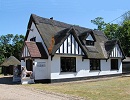Antiques for Sale | Antique Furniture | Antique Fairs | Antiques Listings | Antiques Email Alerts | Websites for Antique Dealers | Contact

Martlesham Antiques
Tel : 01394 386732 and 07889724434
Email : martleshamantiques@btconnect.com
Web : www.martleshamantiques.com/
Web : www.antiques-atlas.com/martleshamantiques/
Martlesham Antiques
The Thatched Roadhouse
Main Rd, Martlesham, Suffolk, IP12 4RJ
Open: Mon to Fri 9am - 5pm, Sat 10am - 4pm, Sun by appointment only.
Early 19th Century pair of grand tour lead models



Description
Incredibly rare pair early 19th Century grand tour sculpted lead models of the canova lions on verde antico marble plinths. The rarity of these two pieces, modeled after the originals carved in marble by Antonio canova, cannot be overstated, you will never see another pair modeled out of lead again, they are without question the rarest of their type, with an absolutely fabulous patina. They came from an important estate and are in excellent condition for their age.Verde Antico, or Verd Antique, or Verde Antique is a serpentinite breccia, popular since ancient times for its decorative uses & is regarded as one of the finest and most valuable of stone. It was known to the ancient Romans and was quarried especially at Casambala, near Larissa and Thessaly, in Greece. Verde antico was much used by the monumental builders of the Byzantine Empire and by the Ottomans after them. The term "Verd Antique" has been documented in English texts as early as 1745.
Antonio Canova, Marchese d’Ischia ( 1757- 1822 ) was an Italian sculptor, one of the greatest exponents of Neoclassicism. Among his works are the tombs of popes Clement XIV (1783–87) and Clement XIII (1787–92) and statues of Napoleon and of his sister Princess Borghese reclining as Venus Victrix. In 1775 Canova set up his own studio in Venice. In 1779 he sculpted Daedalus and Icarus which had been commissioned by Pisani, procurator of the Venetian republic, it was Canova’s first important work In 1783 Canova received an important commission for the tomb of Pope Clement XIV in the Roman church of SS. Apostoli. That same year he was commissioned to execute a tomb in St. Peter’s to Pope Clement XIII. Completed in 1792, it shows a more developed understanding of the classical aesthetic of antiquity than his monument to Clement XIV. The lions on the monument became known as the Canova Lions & are arguably the most famous of lion sculpture ever made. In 1805 he was appointed inspector general of fine arts and antiquities of the papal state. In 1810 he was made president of the Accademia di S. Luca in Rome. He sculpted his well-known Three Graces from 1812 to 1816. After having visited Paris to arrange for the return of Italian art treasures plundered by the French, he went to London ( 1815 ) to give his opinion on the Elgin Marbles. The success of his mission in Paris led to the reward of the title of Marquis of Ischia by the Pope. While in London, the Prince Regent, later George IV, commissioned a life-size group of Venus and Mars. Other late commissions included the Stuart monument in St. Peter’s ( 1819 ), the alteration and completion of the equestrian Napoleon into Charles III of Naples ( 1819 ), and a monument of George Washington idealized in Roman costume, erected at Raleigh, N.C., in 1821. Canova’s domination of European sculpture at the turn of the 18th century and the beginning of the 19th is reflected in countless adulations in memoirs, poems, and newspapers. “Sublime,” “superb,” and “marvellous” are adjectives frequently found describing Canova’s work in his lifetime.
13" x 4 3/4" x 6 1/2" high.
33cms x 12cms x 17cms high.
DateEarly 19th Century :
1820
Codeas256a1235
Price SOLD £1600.00
StatusSold
SellerMartlesham Antiques
Telephone01394 386732 or 07889724434Non UK callers :+44 1394 386732 or +44 7889724434Emailmartleshamantiques@btconnect.com
Contact
Send Martlesham Antiques a message about this item here





